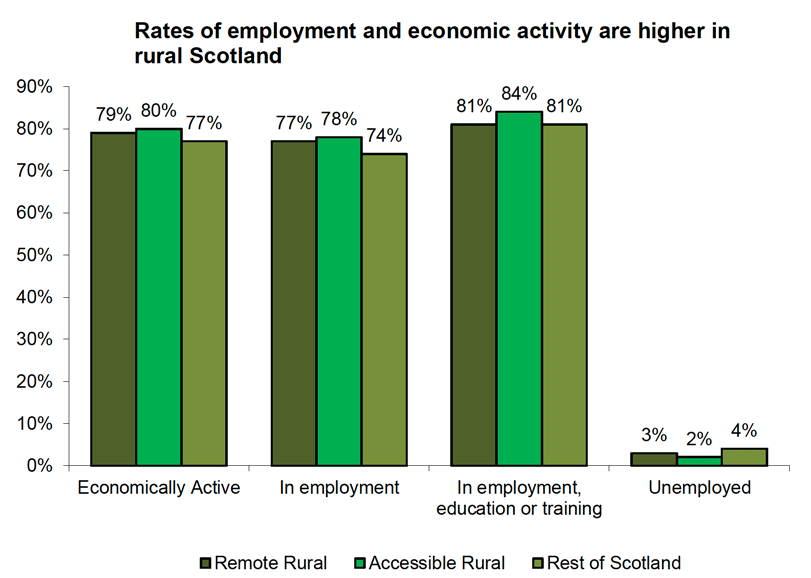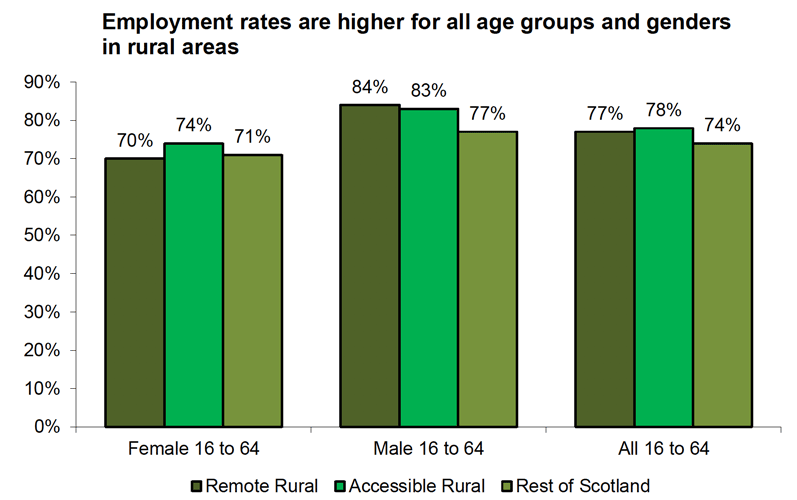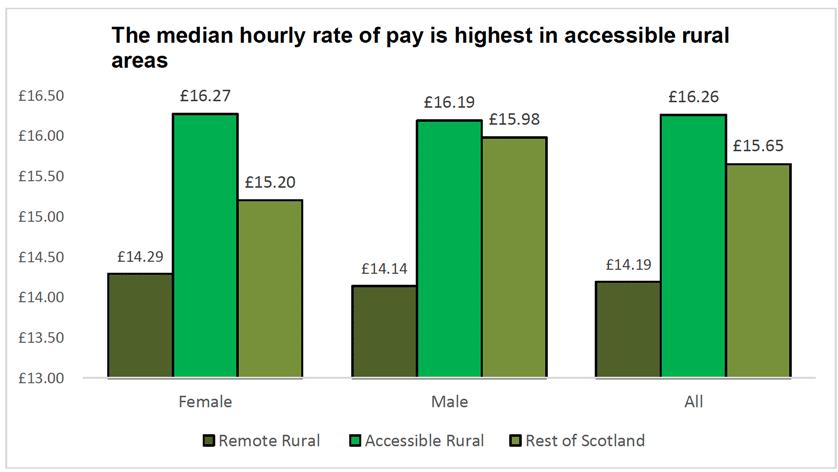Poverty in rural Scotland: evidence review
This report reviews current evidence and research on rural poverty in Scotland
3. Employment
Summary:
- Rates of employment and economic activity are higher in rural Scotland.
- The rate of working-age population that are either employed, in education or training is higher in accessible rural areas and equal to the rest of Scotland in remote rural areas.
- The median hourly rate of pay is highest, for both males and females, in accessible rural areas and lowest in remote rural areas.
- The median gross annual pay is highest for people living in accessible rural areas and lowest for people living in remote rural areas.
- The highest rate of part-time workers can be found in remote rural areas.
There is a strong relationship between unemployment and poverty, both in Scotland and internationally. Poverty rates for households where all adults are in employment are considerably lower than in households where adults are unemployed. Employment, however, does not necessarily lift households out of poverty. The majority (59%) of working-age adults in poverty in Scotland are in 'in-work poverty' – that is, they are living in households with at least one adult in employment. In addition, almost half (47%) of all working-age adults in working poverty were parents of dependent children (Scottish Government, 2019a). Employment data is, therefore, not an infallible measure of poverty but may strengthen our understanding of rural poverty.
3.1 Economic Activity
Figure 3 shows that rates of employment and economic activity are higher in rural Scotland. The economic activity rate (people employed or looking for work) and employment rate (the number of people employed as a percentage of the total population of working age) are higher in rural areas than in the rest of Scotland. The rate of working-age population that are either employed, in education or training is also higher in accessible rural areas and equal to the rest of Scotland in remote rural areas.

Source: Annual Population Survey 2019, Scottish Government (2021b) (using the Scottish Government Urban Rural Classification)
Figure 4 shows that the employment rates are higher for all age groups and genders in rural areas compared to the rest of Scotland. Within rural areas, accessible rural areas have the highest employment rates for all sub-groups, apart from males aged 16 to 64 where the employment rate is higher in remote rural areas.
The highest employment rates in all areas of Scotland are for males aged 16 to 64, with the highest rate being 84% in remote rural areas followed by 83% in accessible rural areas. In the rest of Scotland, the employment rate for males aged 16 to 64 is 77%.

Source: Annual Population Survey 2019, Scottish Government (2021b) (using the Scottish Government Urban Rural Classification)
High employment rates do not necessarily suggest that there are lower rates of poverty in rural Scotland. Indeed, factors such as rates of pay and patterns of employment can contribute to in-work poverty.
3.2 Pay
Low-paid workers face a higher risk of poverty than workers who are not on a low hourly rate of pay. Among full-time, full-year employees in the UK, those that are low-paid are twice as likely to be in relative poverty than all employees (Scottish Government, 2019a).
While labour market statistics look at individuals, poverty is generally experienced and measured at a household level. The assumption is that, although individuals are the recipients of earnings, those earnings go into a 'household pot', together with income from a range of other sources. This means that low pay does not always result in poverty. Indeed, in almost 3 in 10 Scottish households in working poverty, between 2014-2017, no one in paid employment is in low pay (Scottish Government, 2019a).
Similarly, poverty among working families is not always the result of low pay. Around a third of adults in working poverty are not paid below the living wage (Scottish Government, 2019a). For many households, therefore, it is the number of hours of paid work completed by adults in the household that seems to matter. In Scotland, families in part-time employment only and couples where one is in full-time employment and one is not in employment make up over half of families in working poverty (Scottish Government, 2019a). This makes it difficult to use data on rates of pay to determine the extent of poverty in rural Scotland.
Figure 5 shows the median hourly wage rate for all male and female employees residing in rural and urban areas. The median hourly rate of pay is highest, for both males and females, in accessible rural areas and lowest in remote rural areas.

Source: Annual Survey of Hours and Earnings 2020, Scottish Government (2021b) (using the Scottish Government Urban Rural Classification).
Table 6 shows that the median gross annual pay (that is, before tax and other deductions) for all full-time employees is highest for people living in accessible rural areas and lowest for people living in remote rural areas. Annual pay is lowest for females living in remote rural areas and highest for males living in accessible rural areas.
| Remote Rural | Accessible Rural | Rest of Scotland | |
|---|---|---|---|
| Female | £27,231 | £31,678 | £28,405 |
| Male | £32,021 | £35,556 | £34,044 |
| All | £29,652 | £34,311 | £31,531 |
Source: Annual Survey of Hours and Earnings 2020, Scottish Government (2021b) (using the Scottish Government Urban Rural Classification).
Research conducted by Atterton et al. (2019), however, shows that the gender pay gap in mainly rural local authorities has declined substantially in recent years, to the point at which women earn more than men in these areas in 2018. The research found that while the gender pay gap in islands and remote rural local authorities was very high in 2016 (20%), it has since declined substantially. Indeed, in 2018 the gender pay gaps in larger cities and urban with substantial rural local authorities (10.0% and 10.3% respectively) were higher than in islands and remote rural (4.5%) and mainly rural local authorities (-1.9%)[2].
These findings are generally positive for rural Scotland, however, the report is unable to explain why the rural pay gap is declining. Though the study explored some of the potential reasons for the decline – for example, differences in hours worked, employment rates, distribution of women across occupational groups and industrial sectors in different geographies - none were considered major factors.
3.3 Patterns of employment
Low-paid workers are more likely to work part-time (33% - working less than 30 hours per week), compared to all workers (20%). Additionally, low-paid workers who are in poverty are more likely to work part time (41%) than all workers in low pay (Scottish Government, 2019a). As can be seen in Table 7, the highest rate of part-time workers can be found in remote rural areas (28%). Women are considerably more likely than men to work part-time in all areas of Scotland, however, the highest rate is again in rural Scotland (46%).
| Remote Rural | Accessible Rural | Rest of Scotland | |
|---|---|---|---|
| Percentage of employed males who are: | |||
| Self-employed | 29% | 19% | 14% |
| Working part time in main job | 12% | 12% | 13% |
| With a second job | 6% | 3% | 3% |
| Homeworkers | 10% | 9% | 3% |
| Percentage of employed females who are: | |||
| Self-employed | 16% | 15% | 8% |
| Working part time in main job | 46% | 46% | 40% |
| With a second job | 10% | 5% | 4% |
| Homeworkers | 12% | 10% | 4% |
| Percentage of all employed who are: | |||
| Self-employed | 23% | 17% | 11% |
| Working part time in main job | 28% | 28% | 26% |
| With a second job | 8% | 4% | 3% |
| Homeworkers | 11% | 9% | 4% |
Source: Annual Population Survey 2019, Scottish Government (2021b) (using the Scottish Government Urban Rural Classification)
Contact
Email: socialresearch@gov.scot
There is a problem
Thanks for your feedback